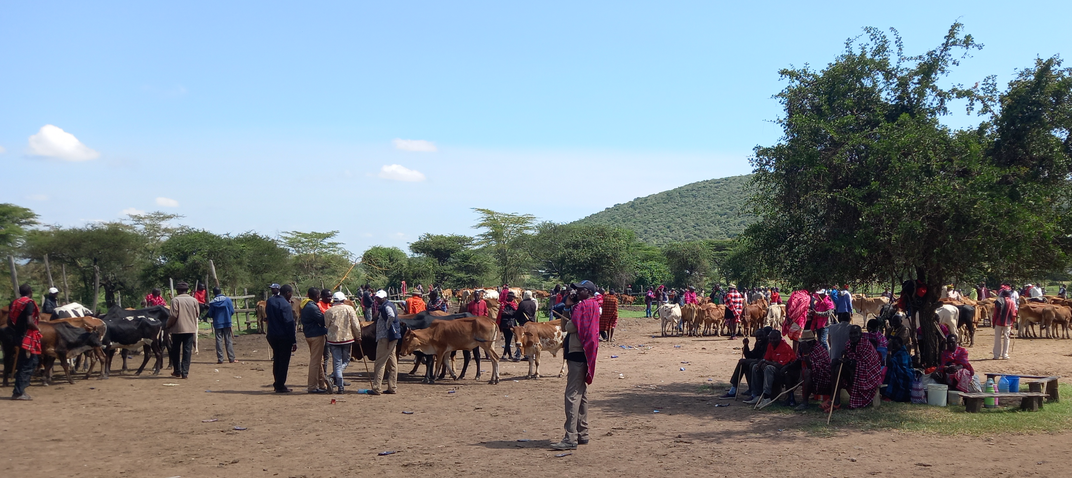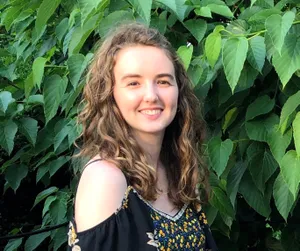Bringing the Masai Mara to the National Mall
Kenya’s Masai Mara ecosystem is an ancient landscape grappling with very modern challenges. Conservationist Cindy Obath discusses plans to better represent the daily reality of local communities during the Earth Optimism × Folklife Festival.
:focal(1824x994:1825x995)/https://tf-cmsv2-smithsonianmag-media.s3.amazonaws.com/blogging/featured/KenyanLivestockMarket.jpg)
Imagine going on an African safari. What would you expect to see and hear? Whether you mean to or not, you’re probably conjuring images of the Masai Mara – a corner of southern Kenya that’s famous for its stunning grassland views and abundant wildlife.
If you asked people who live near the Masai Mara the same question, do you think they’d see the landscape in the same way? The Mara is the ancestral home of the Maasai people – pastoralists that once herded their livestock across the plains in accordance with the seasons, just like the millions of wildebeest and other wildlife that lived alongside them. Other communities in the region have developed into more urban spaces, or industrial-style ranches that impede ancient migration paths. Many people are struggling to adapt their lifestyles to the changing landscape – not to mention the increasing threat of climate change. The daily reality for these locals is often very different from the experiences of tourists that come to see the wilderness of the Mara’s conservation areas.
Cindy Obath is a Kenyan conservationist who wants to explore different perspectives of the Mara – and the connections between Animals, Plants, and Us – at the upcoming Earth Optimism x Folklife Festival. Typically, she works with organizations like the One Mara Research Initiative and Smithsonian Conservation Biology Institute to translate research into policy and conservation action across the Greater Mara ecosystem. As the Festival approaches, she has been bringing together a delegation of Kenyan conservation leaders to demonstrate how they work together to address the modern threats facing the Mara.
We met with Cindy over Zoom to discuss her creative ideas to bring the Mara – and all of its challenges and opportunities – to the National Mall this summer. This interview has been edited for length and clarity.
The Masai Mara is well known across the world, but the public perception is often very different from the experience of living there. What are some misconceptions that you'd like to address about life in the Mara?
I know if I tell people about the Mara, even people who've been there before, they see it as a tourist destination. They're looking to see green landscapes and “the Big Five” and all sorts of things, which isn't terrible. It’s a prolific landscape. I think it’s important for us to be able to celebrate that, and for tourists to come and enjoy the heritage that we have.
But what does it look like today, for someone living in that kind of landscape? Yes, you might see Maasai community members wearing their shuka [a versatile traditional garment] and beads, but that's not necessarily how people are living when the tourists aren't there. I want to highlight what the Masai Mara looks like from a day-to-day perspective as opposed to from a tourism perspective. I think that it’s important to let people know what's really happening on the ground.
How would you emphasize the importance of protecting this environment, especially for young people who may not know much about the Masai Mara?
I would actually open that question up. It's not just for the younger generation – there are my peers who don't understand the importance of different species within an ecosystem. I can understand that it's difficult. Scientists can tell you that information, but it's daunting; it's heavy. Things like the wildebeest migration are a bit far removed from the average Kenyan. It's not something that's important to them because, quite frankly, it doesn't put food on the table at the end of the day. Elephants, giraffe, and lions in the African Savannah get a lot of attention, but how do you do that for a wildebeest? It's a bit ratty looking!
A lot of what I do is try to make things less heavy, yet still bring the message home. Children are great because when you explain something simply to a child, they are going to understand and appreciate it, especially if they can see that you care about it. They'll start feeling like they need to care about that too. We have a bunch of children’s book authors that are doing really good work to start conversations about identity, ecology, wildebeest, elephants, and stuff like that. I think it would be good for kids, and eventually good for adults.
You can always consider and adapt to different audiences. Start having conversations that are less heavy and just get people to understand how the Mara landscape works. It's a bit of an uphill battle, but not impossible.
What are you most excited to bring to the Folklife Festival?
We want to bring the old and the new – bring the culture and the history, but also really bring what's happening in the 21st century. We've got these four different organizations who are coming together under one essential vision, and that's why we envisioned the exhibit like a boma. A boma is where they keep livestock, and sometimes they separate it into little partitions for the different types of livestock, like cows, sheep, and goats. We want to do a similar thing but give it a bit more flow. A wealth of researchers currently work in the Mara, but that knowledge is still not necessarily going into management, so you've got an organization dealing with that. You've got an organization dealing with livelihoods and youth and women empowerment. You've got organizations who are helping with human-wildlife conflicts and poaching to reduce those kinds of security incidences. I want to capture someone's eye and tell the story from a bigger picture as opposed to it just being different organizations showcasing themselves.
People can walk around into the “boma,” and we see these organizations who are dealing with 21st century problems in this ancient landscape. They’ll be talking about the work that they're doing, how they're making things better, and how they're helping the Mara stay alive and thrive in a time when there's so much change that is affecting it. We need to give a story of hope, especially considering the last two years. I think it's important for us to say that while there's all these things happening, we've got some people who are helping us out, and this is what they're doing.
Everything seems promising so far! I can't wait to come and see it all in action. What makes you so optimistic about the Mara's future?
When you've spent enough time in landscapes like the Mara, working in the conservation field with all sorts of different people, it sometimes becomes difficult to stay hopeful. A lot of people that I work with have a very gloomy outlook of the Mara and what's currently happening, but that makes me hopeful at the same time. These people are more vocal about how quickly things could change, and therefore how quickly we need to change them. I think that people are finally listening. I see changes in how the local community is viewing conservation from different aspects – not just wildlife, but looking at it from an economic point of view. What activities can we do? How can we compliment this? They're beginning to see the bigger picture
There are so few other landscapes in Kenya that you can say get the attention that the Mara is currently getting. Speak to anyone about Kenya and they know the Maasai Mara. It’s no longer just about where the wildebeest migration is – it’s about how we have to save the wildebeest migration because we may not be able to see it in the future. So how are we going to get this done? That makes me hopeful. There really isn't much to go on these days, so you've got to grab hope where you can.


